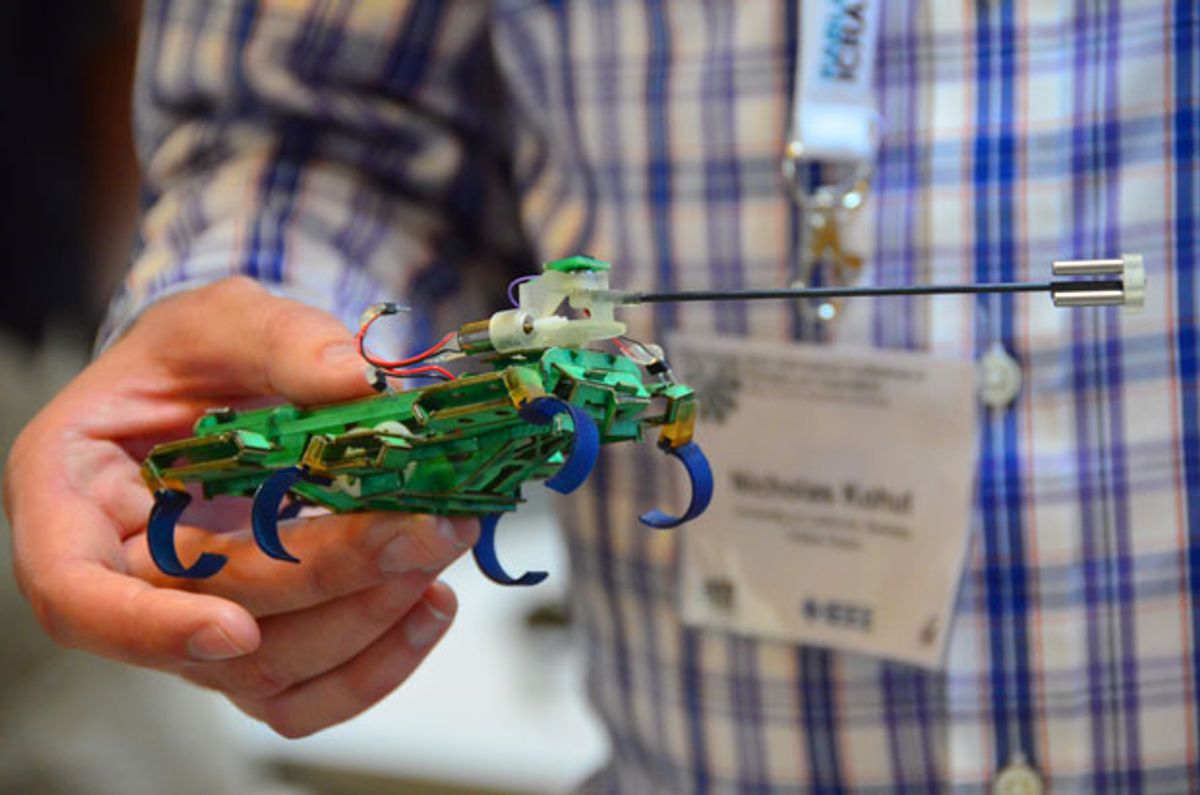When researchers at UC Berkeley figured out what kinds of awesome things were possible when you endowed a robot with an actuated tail that it could use for pitch control, it earned them an article in Nature, which is only slightly less prestigious than an article in IEEE Spectrum. Anyway, the Berkeley students have been exploring what else you can do when you give ground robots bio-inspired accessories, and they've got some little legged robots doing cool new stuff thanks to the addition of wings and tails.
We’re going to take a look at three papers in this article, all of which were presented at ICRA 2013 last month. The first one builds directly off of the Nature paper, involving the use of an actuated tail to provide control in midair like lizards do (and dinosaurs did). While the Nature paper just dealt with using a tail for pitch control, real lizards are much more capable, and can reorient themselves to upright no matter how you drop them. To emulate this behavior, researchers constructed a robot with a two degree of freedom tail, with the ability to yaw as well as pitch. By combining yaw and pitch to move the tail in a sort of circular motion, the robot can correct pitch, yaw, and roll, meaning that you can fling it however you want and it’ll be able to land on its feet. If it had feet, anyway. Watch:
This robot is a simple implementation of the concept to see whether it works or not: it’s a body with a tail and some servos along with an Arduino board and some accelerometers, without other sensors or limbs or anything. We’d like to imagine that future research will equip a larger, more capable robot like XRhex with a 2 DoF tail so that we can see some fancy aerial maneuvers.
"A nonlinear feedback controller for aerial self-righting by a tailed robot," by Evan Chang-Siu, Thomas Libby, Matthew Brown, Robert J. Full, and Masayoshi Tomizuka, from the Department of Mechanical Engineering, University of California Berkeley, was presented last month at ICRA 2013 in Germany.
There are plenty of animals out there with tails who use them for things besides midair orientation changes. Having a big movable mass that sticks out behind you provides a way to change orientation even if you’re on the ground. Cheetahs do this, and now robots do too, and it’s spectacularly effective on small legged platforms. In fact, it’s so effective that the addition of a rotating tail has turned a robot called TAYLRoACH (Tail Actuated Yaw Locomotion Robotic Autonomous Crawling Hexapod) into what could be the world’s fastest turning robot:
The peak controllable turning rate of TAYLRoACH is about 360 degrees per second with an accuracy of close to five degrees, even while the robot is running along at over three body lengths per second. Because the method of turning is completely independent of the legs, turning the robot doesn't slow it down, but more importantly, it doesn't require a lot of gripping force, so the robot can turn even on very slippery surfaces. The only problem with the tail is that it doesn't have an unlimited range of motion, so making two quick turns in the same direction in succession is difficult. The tail can be slowly moved back to zero and turn the robot again, but a more intriguing idea presented in the paper is to just "develop a tail with an unlimited range of motion." Take that, nature!
"Precise Dynamic Turning of a 10 cm Legged Robot on a Low Friction Surface Using a Tail," by N.J. Kohut, A.O. Pullin, D. W. Haldaney, D. Zarrouk, and R. S. Fearing, from the Department of Mechanical Engineering, University of California, Berkeley, was presented last month at ICRA 2013 in Germany.
This last little robot is VelociRoACH. You'll notice that it looks a lot like TAYLORoACH, except that instead of a tail, it's got those adorable little wings. These wings aren't made for flappin,' though: they're passive, used for stabilization. When you get little tiny robots to run around super fast on legs, rotational stability starts to become a problem, but a pair of wings works wonders for allowing the robot to traverse obstacles at high speed without flipping itself over:
If you look closely in the video, at the end, you can see where this research may be going next: the end of the tail has a bit of plastic on it that acts as a sail, providing an additional method of control. Also, the wings are currently completely passive, but with a little bit of actuation, they could be used to provide lift or downforce or maybe lift on one side and downforce on the other, if you wanted to get crazy. And we're always in favor of getting crazy.
"Animal-inspired Design and Aerodynamic Stabilization of a Hexapedal Millirobot," by Duncan W. Haldane, Kevin C. Peterson, Fernando L. Garcia Bermudez, and Ronald S. Fearing, from the Department of Mechanical Engineering, University of California, Berkeley, was presented last month at ICRA 2013 in Germany.
Evan Ackerman is a senior editor at IEEE Spectrum. Since 2007, he has written over 6,000 articles on robotics and technology. He has a degree in Martian geology and is excellent at playing bagpipes.




